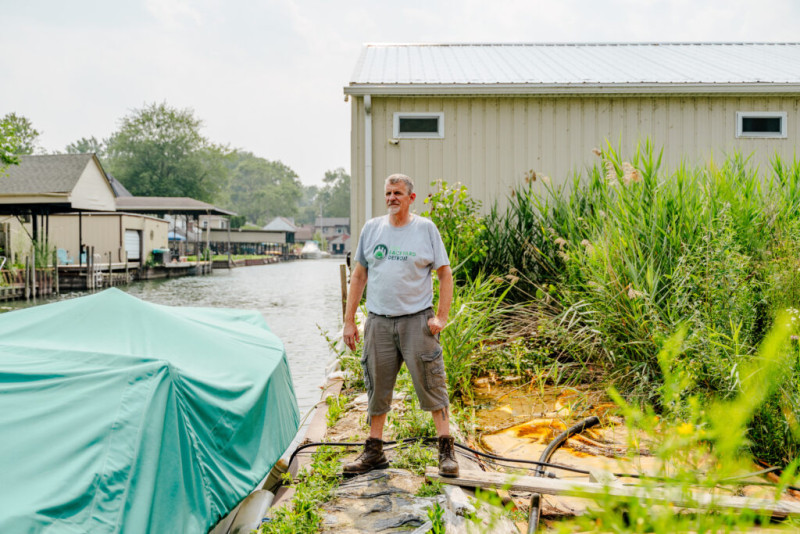Climate Costs Imperil Unique, Diverse Detroit Neighborhood
DETROIT — In 2019, Blake Grannum experienced a catastrophic flood in her home in Detroit’s Jefferson Chalmers neighborhood. Water overtopped nearby canals and rushed into her basement, destroying a washer and dryer and forcing her and her mother to go to the laundromat during the pandemic.
It was one of several floods the neighborhood experienced in recent years; heavy rains overwhelmed sewer systems and flooded basements five times between 2011 and 2021. During that last major flood on July 21, 2022, six inches of rain fell on the region, inundating freeways, stranding hundreds of people in vehicles, and filling basements with sewage backup.
Jefferson Chalmers has been called the “Venice of Detroit.” It’s a unique, historic neighborhood, oriented around a canal system and waterfront parks, and built on one of the vast swamps that once lined the Detroit River and Great Lakes.

The city of Detroit installed inflatable Tiger dams across the Jefferson Chalmers neighborhood in 2020 in an attempt to stem the floods. Photo by Demetrio Nasoi.
Neither the overbank flooding from the canals nor the sewer backups have put Grannum off the neighborhood. She now lives with her fiancé in a house that sits a few feet beneath the flood wall, next door to her childhood home.
And it’s clear why she might want to stay. From the dock in Grannum’s backyard, you can watch boats idle past and look out on the many ramshackle boathouses on Harbor Island in a neighborhood surrounded by water.
“It’s just a vibe here,” Grannum said. “You have different income groups, different cultures, different types of people living in this area.”
But some worry the costs that come with flooding could potentially create a process of “climate gentrification” here. In cities like New Orleans and Miami, this process has seen wealthier and whiter residents displace low-income residents and people of color in less flood-prone areas.
But in Jefferson Chalmers, climate gentrification could mean that those with the resources to manage the risks and expense of living in a floodplain may replace those without them.
The neighborhood is already changing; it’s become more white in recent years. In 2016, 88% of the neighborhood residents were Black, and just 8.5% were white. In 2021, 74% of residents were Black, lower than the citywide average of 78%. Whites now account for 18% of residents here.
Incomes are also rising. In 3 of 7 census block groups within the neighborhood, median income increased by between 13% and 80% since 2020. The median household income in 2021 was $56,395, higher than the city’s median of $34,762.
And home renovations are increasingly common while housing prices are rising. Meanwhile, a redevelopment plan for the neighborhood calls for $640 million in new investments, mostly new housing and retail. A streetscape renovation and several new businesses and developments have brightened up a stretch of Jefferson Ave. that hadn’t seen much love in decades.
Still, Jefferson Chalmers remains among the city’s lowest-income neighborhoods, with 39% of residents living below the poverty line, higher than the citywide average of 32%.
And now, the forces of climate change threaten to make the area increasingly unaffordable for those low-income residents.
In 2021, the Federal Emergency Management Agency placed the neighborhood in a designated flood zone, requiring homeowners with federally insured mortgages to carry flood insurance. Only about 35% of units in the neighborhoods have mortgages. Those that do could pay thousands of dollars more a year for flood insurance if they’re federally insured. The designation has also paused some affordable housing developments in the neighborhood that rely on state and federal financing.
Meanwhile, the city of Detroit has signaled it will fine or litigate against those with defective or missing seawalls if they don’t bring them into compliance. Seawalls can cost tens of thousands of dollars to replace or rehab.
Residents see an existential threat from both the high costs and high water. These frustrations, coupled with climate change uncertainty, have left some questioning the neighborhood’s future.
“Is it time to turn the page in the Jefferson-Chalmers neighborhood?” longtime Jefferson Chalmers resident Frank Bach wrote on the website Nextdoor. He pointed to the extreme fluctuations in water levels and the neighborhood’s location on a former wetland as challenges that might be difficult to overcome.
“What was made here in the 1800s isn’t working anymore,” he wrote.
Plans to Save a Neighborhood
Getting the neighborhood out of the designated flood zone is a high priority for those who want to see redevelopment continue.
In 2022, city officials held a meeting to present a $161 million U.S Army Corps of Engineers plan that would have built berms along the riverfront, closed off the connection of two canals to the river, and installed a removable stop-log dam – a barrier to keep out high water – on the deepest channel connecting the canal system with the Detroit River. They planned to pay for it with federal funding.
But residents blocked the proposal, fearing it could disconnect the neighborhood from the river, destroying its character and leading to stagnant, bug-infested canals, where a Great Lakes Water Authority outfall also periodically dumps combined sewage and stormwater. Residents said there was a level of distrust that the city would effectively manage the stop-log dam, considering Detroit’s history of financial problems and poor city services.

Following the rejection, the city said it would proceed with fining and litigating against the owners of 107 homes it determined to have missing or deficient seawalls. But city spokesperson Georgette Johnson said the city will wait until it has repaired seawalls on 17 city-owned parcels before going after other property owners. They’re targeting this fall for completion.
Several residents who spoke with Planet Detroit supported another proposal spearheaded by resident Jay Juergensen, a Jefferson Chalmers resident and lead organizer for the Jefferson Chalmers Water Project community group.
Along with large investments in regional stormwater infrastructure, the plan seeks $40 million to create wetlands and levees on the Detroit River, make topographical changes, and fund seawalls on the canals. Juergensen estimates that the seawalls would cost around $11 million.
It’s unclear if Juergensen’s plan has found any official support. In a segment on Detroit Public Television’s “One Detroit” program, Tyrone Clifton, director of the Detroit Building Authority, referred to it as “ambitious.”
Without financial assistance and coordination, the process of hardening Jefferson Chalmers’s shoreline will likely be lengthy and expensive – and may still fail to remove the neighborhood’s floodplain designation.
FEMA previously told Planet Detroit that seawalls may be recognized as part of an effective flood mitigation plan. But Ken Hinterlong, senior engineer for FEMA, said any reevaluation would also need to ensure that there is adequate “interior drainage” in the neighborhood once levees and seawalls are built, something that could continue to be a challenge for an area that was previously a wetland and has experienced frequent sewer backups.

John Myers, who lives on the Fox Creek canal, said the city can’t treat the problem as the responsibility of individual property owners because a continuous barrier is needed. He said residents would get a better deal if these improvements were solicited in bulk.
“We wouldn’t all try to pave our little section of the street in front of our house,” he said.
How to Get Out of a Flood Zone
One of the residents with resources to deal with flooding is Nicole de Beaufort, who lives on Jefferson Chalmers’ Fox Creek canal. She and her partner, who own their home outright, invested their savings in raising and hardening the seawall to protect the property against future floods.
“All told, we spent about $50,000, which feels like an incredibly large sum of money,” she told Planet Detroit. “So it makes me feel extremely fortunate that we could (do that), but I recognize that that opportunity is not available to my neighbors. It feels unfair that we have individual solutions instead of systemic solutions.”
Michelle Lee, a Jefferson Chalmers resident who was previously director of housing and neighborhood stabilization for the nonprofit community development corporation Jefferson East, Inc., believes some amount of public funding will be needed to help residents repair seawalls, noting that many people in the neighborhood still struggle to afford things like furnaces after the widespread basement flooding in 2021 destroyed many appliances.

Citations for missing or poorly maintained seawalls point to the difficulties of addressing the issue. According to records obtained by Planet Detroit, the city ticketed 23 properties for inadequate seawalls in early 2021. Johnson from BSEED said just four properties have since been brought into compliance.
Meanwhile, the development of affordable housing in the neighborhood is on hold.
“Every project going up in Detroit has to use some type of federal money,” Lee said. Community Development Block Grants and Home Investment Partnership funds offered by the Department of Housing and Urban Development contribute to many such projects. However, an executive order previously directed federally funded development to avoid floodplains.
A special assessment district, a levy to pay for improvements that benefit a specific area, is another option for generating funds for seawall repairs that several residents expressed support for. In 2022, officials in Midland and Gladwin counties approved a SAD for certain properties to repair dams that were damaged in the 2020 flood. Although such a plan in Jefferson Chalmers would compel some residents to pay for improvements to someone else’s property, it could be a net benefit for everyone who lives in the floodplain.
Johnson said the city would neither advocate for nor oppose a special assessment district.
An Uncertain Future
One shortcoming of FEMA’s flood maps is that they’re based on past data. Richard Rood, a climate scientist at the University of Michigan, said that the practice of using historical averages to calculate risk is no longer working.
“How quickly things are changing is something that we don’t appreciate,” he said. “Right now, each 10-year period is exhibiting a statistically different climate than the previous 10-year period.”
And while climatic extremes could produce both exceptionally wet and dry periods, Rood predicts the “next few decades are very wet.” This aligns with data from the last few decades showing most of the eastern U.S. getting more precipitation as the West gets drier.
If enforcing seawall requirements proves unworkable, city and state leaders could ask FEMA for assistance in relocating residents away from the floodplain.
Voluntary buyout programs as part of a “managed retreat” process for moving people away from areas likely to be impacted by climate-fueled disasters have reduced the flood risk for many in other regions.
But the FEMA buyout program has also been criticized for facilitating “white flight” on account of its tendency to move white residents away from racially diverse neighborhoods to majority-white areas. For now, Johnston said the city of Detroit is not considering asking for such a buyout.
“You can’t put a price tag on this neighborhood,” Grannum said. “You come here, you’re still in the city, and it’s quiet. You can experience nature, and it’s on the water in the city of Detroit.”
Lee worries about the neighborhood’s older residents getting pushed out due to expenses associated with flood insurance, seawalls, and cleaning up from floods and basement backups. They may be able to sell their homes for high prices, but Lee said that still won’t offset the costs of moving and studies show the financial benefits of aging in place.
She added that her older neighbors could also lose a sense of community and means of finding support if needed.
“People want to stay here,” she said. “They raised their kids here; they know their neighbors…you need those types of connective tissues.”
Meanwhile, de Beaufort is questioning her decision to invest in the neighborhood.
“The public will in our community is to have a beautiful neighborhood that enjoys this amenity of the water,” she said. “But I don’t know if the political will is there to address this systemically, and that’s disappointing.”
This piece is part of a collaboration that includes the Institute for Nonprofit News, Borderless, Ensia, Grist, Planet Detroit, Sahan Journal and Wisconsin Watch, as well as the Guardian and Inside Climate News. The project was supported by the Joyce Foundation.
Disclaimer: The copyright of this article belongs to the original author. Reposting this article is solely for the purpose of information dissemination and does not constitute any investment advice. If there is any infringement, please contact us immediately. We will make corrections or deletions as necessary. Thank you.







